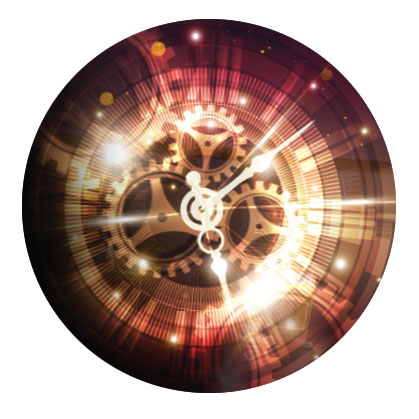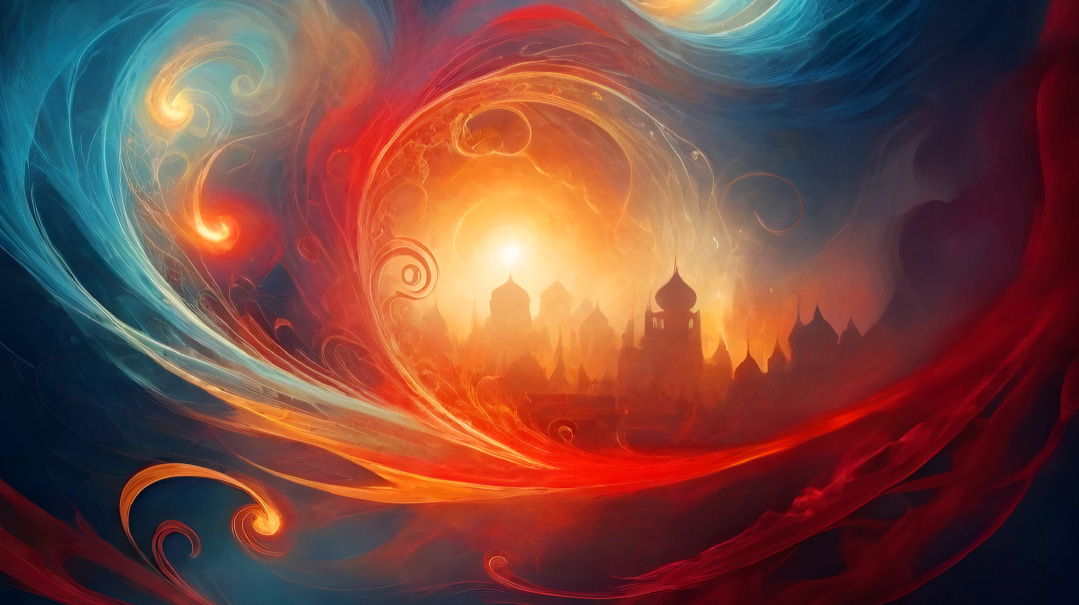An Out-Of-This-World Experience


Erev Shabbos is for doing. Shabbos is for being
Sometimes even those of us with prolific imagination find it challenging to grasp ideas that are the bread and butter of Jewish life. Who truly understands how nevuah functioned? What Olam Haba is? What it means to have an immortal soul?
Hashem endowed key spiritual realities with physical counterparts, so we mortals can fathom the otherwise abstract concepts. Nevuah becomes relatable when we consider its similarity to dreams. Death becomes more concrete when we compare it to sleep. And Olam Haba, say Chazal, is experientially akin to Shabbos (Berachos 57b). These comparisons are referred to as a mei’ein, a taste of their spiritual counterpart.
One out of Sixty
A mei’ein is actually a halachic metric, measuring a sixtieth of a whole. This figure is familiar from the drop-of-milk-in-the-chicken-soup scenario, wherein we are permitted to eat the soup provided that the drop of milk is less than a sixtieth of the total volume of soup. Why a sixtieth?
Rabbi Akiva Tatz explains that a mei’ein is the amount that signifies the borderline of human perception. When the drop of milk is less than a sixtieth of the soup’s volume, its taste cannot be discerned, and this makes the soup permitted.
Mei’ein, a sixtieth, is not only a technical or halachic gauge. Shabbos is mei’ein Olam Haba. Keeping it according to the letter and spirit of the law places us on the borderline of perception, where we can glimpse the cusp of Olam Haba.
Now, I know my freshly baked challos are otherworldly, but to actually sense Olam Haba? Isn’t that a bit of a stretch? How can the exhaustive, meticulous scope of hilchos Shabbos — I can hardly make a move without considering the halachic ramifications — give me a sense of Olam Haba?
Preparation is Everything
Chazal, known for cloaking profundity in simplicity, teach: Mi shetarach b’Erev Shabbos yochal b’Shabbos (Avodah Zarah 3a) — One who prepares for Shabbos will eat on Shabbos.
Isn’t this obvious? What are Chazal telling me that I don’t already know?
I’ll always remember the Friday night when I realized, 20 minutes after lighting candles, that I had forgotten to make a cholent. And we were having guests on Shabbos day!
Anticipation of a sparse Shabbos meal merged with the awareness that there was absolutely nothing I could do about it. It was too late. Erev Shabbos was the time allotted for cooking; whatever I had prepared then, I would enjoy on Shabbos. All the regrets in the world couldn’t compensate for a dish I had not prepared.
Erev Shabbos is for doing; Shabbos is about being. This world is for doing; Olam Haba is about being.
“Shabbos occurs weekly to teach that… ultimately, sooner or later, there will be a final end to the work phase and the long Shabbos will begin. The illusion of immortality which we allow ourselves is powerful — I have forever to live. We never have more than seven days before we are reminded: remember Shabbos.” (Living Inspired, Rabbi Tatz)
Eye the Clock
Shabbos models the relationship of this world to the next. All day Friday, with an eye on the ticking clock, I ration my minutes, racing from one task to the next. Ever attentive to potential distractions (no, now is not the time to ambitiously change the buttons on my weekday skirt), I keep my eye on the goal: reach candlelighting time with family and home all ready for Shabbos.
From the moment we’re born, the clock starts ticking. Hashem allots each of us a finite timetable to accrue infinite merit. But life seems to unroll endlessly ahead and we think we have forever to live. Only the truly vigilant are hard at work, carefully budgeting their time for worthy endeavors. They haven’t lost sight of the ultimate goal: reaching the next world with a soul that’s ready for Olam Haba.
Shabbos and Olam Haba are not for doing. They are about being.
If Shabbos descends when my home is a mess, my children unbathed, and the chicken sitting raw on the counter, I will experience the acute pain of lack. The work stage is over and the Shabbos atmosphere I have created endures, an encompassing fixture for the next 25 hours.
When life draws to its inexorable end, each of us will encounter the striking dichotomy of the person we became versus the person we wished we had become. But here, the acute pain of lack is compounded by the tragic awareness of irretrievable loss. The mitzvos that slipped like sand through my fingers, the middos still jagged and coarse, the words neither sifted nor sorted, are irremediable. The exquisitely honed person I did not become will never be. The person I am when I enter the Next World will endure for eternity.
The King Is Coming!
The correlation between Shabbos and Olam Haba is more than an allegorical reminder to heed our opportunities in this world. If Shabbos is actually mei’ein Olam Haba, then tucked deep within Shabbos, dimly sensed, is a genuine encounter with the Next World. Shabbos has the unique distinction of being the only mitzvah with a greeting ceremony: Kabbalas Shabbos. There’s no Kabbalas Pesach, Kabbalas Bris Milah or Kabbalas Mezuzah.
“On Erev Shabbos… Rabi Chanina would go forth dancing and proclaim: ‘Let us go to greet the Shabbos Queen.’ …Rabi Yanai would attire himself and say, ‘Approach, bride! Approach, bride!’ ” (Bava Kamma 32a)
Who was the queen Rabi Chanina welcomed? Who was the bride Rabi Yanai yearned to meet? And whom do we acknowledge every Leil Shabbos in Lecha Dodi when we face the entranceway, bow, and declare, “Bo’i Kallah, Bo’i Kallah”?
“And for the entire duration of Shabbos, man exists in an authentic state of standing before the King” (Shabbos Malkesa, Rav Shimshon Dovid Pincus).
When Rabi Chanina welcomed the queen, when Rabi Yanai entreated the bride, and when we bow to the kallah at Kabbalas Shabbos, the visitor who crosses the threshold is none other than… Hashem Himself. For the next 25 hours we bask in His presence. We reserve the ceremony of Kabbalas Shabbos only for this mitzvah because Shabbos is the only time we encounter Hashem as our guest.
“For the truth of the matter is that the kedushah of Shabbos is higher than all the kedushos and all the holidays, even [higher than] Yom Kippur” (Sifsei Chayim, Vol. 3).
Viscerally, we recognize that no other event in the Jewish calendar carries the level of kedushah we enjoy on Shabbos. Whoever has experienced an authentic Shabbos cannot deny the palpable sense of something that pervades the home once the candles are lit. That something is actually Someone, the King, on His weekly visit.
Suddenly the intricacy of hilchos Shabbos makes perfect sense. When I serve dinner to my family on a regular weeknight, doing it just right is hardly imperative. But hosting the King is an occasion that influences every facet of my life; the way I prepare my coffee, set the table, heat the food, mash my eggs, and tidy the living room. Because they’re important to the King and He is here with me, my Guest of Honor.
The Ramchal thus describes the sublime experience of the Next World: “To rejoice in Hashem and to derive pleasure from the emanations of His Shechinah, as this is the truest joy and greatest of pleasures that can be found” (Mesilas Yesharim, Ch. 1).
Olam Haba is a wholly immersive encounter with the King. On Shabbos, man exists in an authentic state of standing before the King. Differing only in degree and gradation, Shabbos and Olam Haba are one and the same. One is but an undiluted expression of the other, sixty parts to one.
Every week we prioritize our Erev Shabbos tasks, designating only the most pressing ones for attention. In tandem, year after year, we categorize and classify our efforts in this world, determining where to invest ourselves. And with the faint whisper of Olam Haba as weekly encouragement, we groom ourselves for the opportunity to partake in the ultimate Shabbos: Olam Haba with the King.
Originally featured in Family First, Issue 614. Mrs. Elana Moskowitz has been teaching in seminaries for nearly 20 years
Oops! We could not locate your form.






